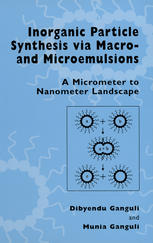

Most ebook files are in PDF format, so you can easily read them using various software such as Foxit Reader or directly on the Google Chrome browser.
Some ebook files are released by publishers in other formats such as .awz, .mobi, .epub, .fb2, etc. You may need to install specific software to read these formats on mobile/PC, such as Calibre.
Please read the tutorial at this link: https://ebookbell.com/faq
We offer FREE conversion to the popular formats you request; however, this may take some time. Therefore, right after payment, please email us, and we will try to provide the service as quickly as possible.
For some exceptional file formats or broken links (if any), please refrain from opening any disputes. Instead, email us first, and we will try to assist within a maximum of 6 hours.
EbookBell Team

4.7
26 reviews"Nanotechnology" is now very well known as one of the most important key technologies in science and industry. In the field of material science and engineering, nanoparticles should be unit materials, as well as atoms and molecules, to build ceramics, devices, catalysts, and machines, and the "nanoparticle technology" is thus attracting. This novel technology includes various methodologies for nanoparticles: preparation, surface-modification via chemical and/or physical treatments, immobilization and arrangement on supports or substrates, to achieve high performance for luminescence properties in light emitting devices, and high efficiency for catalytic and photocatalytic reactions in chemical synthesis, chemical decomposition, and artificial photosynthesis, etc. It should be needless to say that the preparation of nanoparticles, having precisely controlled particle size, size distribution, chemical composition, and surface properties, is essentially important to realize "true nanoparticle technology". This book, written by Dr. Dibyendu Ganguli and Dr. Munia Ganguli, deals with the preparation methodologies for inorganic nanoparticles using macro- and microemulsions as "microreactor". There are several differences between these two emulsions, in addition to water droplet size: thermodynamic stability, and fusion-redispersion dynamics of the droplets. The properties of the nanoparticles prepared in these emulsion systems are seriously influenced and controlled by the selection of dynamic and static conditions.